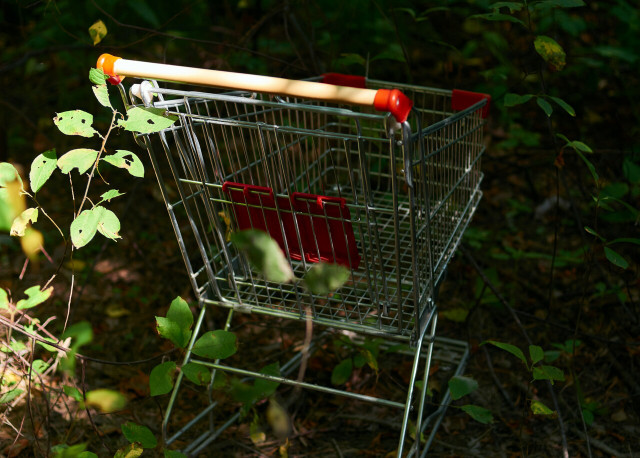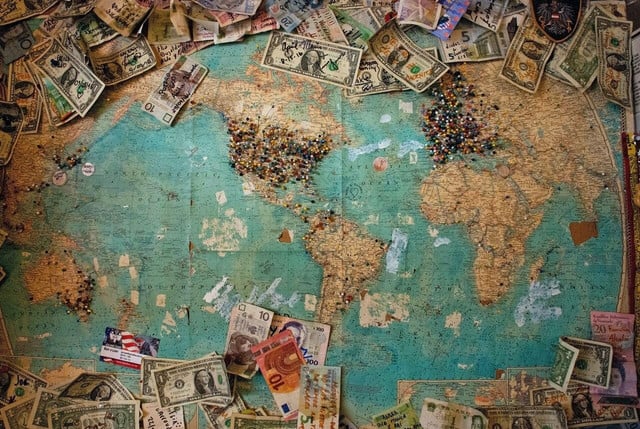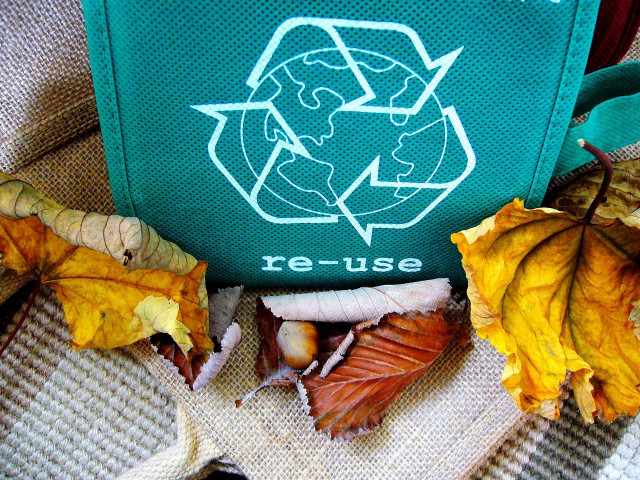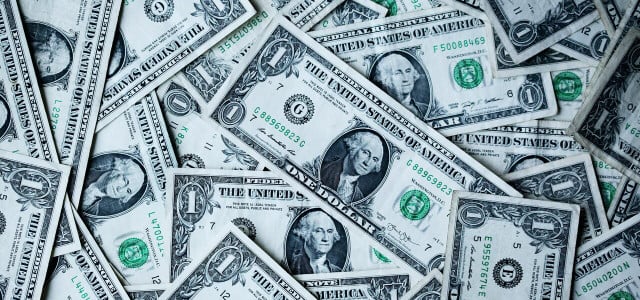Looking for examples of consumerism? It’s more than fast fashion and roomy cars: basically it’s everything that sustains a capitalist and booming economy. But do these things also sustain a high quality of life and planetary wellbeing?
There are examples of consumerism in every corner of the globe because humans have always consumed. It’s an innate and necessary part of our existence. Up until recent decades though, humans generally consumed what they needed — as opposed to what they wanted. Therefore, the term consumerism has evolved to be associated with the unrelenting acquisition of goods and services. Consumerism is the core and vital ideology of global capitalism. It is essential for the health of a capitalist economy that people buy things — otherwise it risks collapse.
The term ‘consumerism’ was first penned by the economist and engineer, Sidney A. Reeve, in his 1921 book, called Modern Economic Tendencies. Reeve was discussing how goods had to appeal to the consumer in order to sell well. Just over 100 years later, and goods are appealing and selling so well that it looks as though we have created a capitalist society of over-consumption that might just annihilate our planet and wellbeing.
National Geographic points out that Americans and Western Europeans have held the monopoly on consumerism for decades, but recently, less capitalist regions of the world are quickly catching up to create a ‘consumer class’ of 1.7 billion people globally. This emergence of over one billion new consumers, has sizeable environmental impacts — particularly due to a diet based strongly on meat and possession of over one-fifth of the world’s cars.
Many experts warn that this is driving climate change and environmental chaos. If the global population reaches its predicted 9.6 billion by 2050, we will need the natural resources of three planet Earths to sustain our current lifestyle.
So, is consumerism the foundation of our society? What exactly is it and what are examples of consumerism in our lives? And more importantly, is our consumerism driving the forces that threaten our very existence on the planet? Let’s take a look.
4 Examples of Consumerism: Understand the Process and What Drives It

Various factors drive our current cycle of consumerism in the west. A materialistic culture, high-level wants and desires, and high living standards all contribute. Advertising and marketing tactics also play a major role in influencing our purchasing psychology.
Planned obsolescence — whereby companies deliberately design products to expire or become outdated — is a tactic frequently used by major corporations to increase spending. New car models every year, constantly updated versions of technology and software, and planned system malfunctions are just some common examples.
Propaganda has been at the heart of marketing ploys for decades. Science, expert opinions and research are frequently employed (and often manipulated) by businesses to sell their products.
A man called Edward Bernays — nephew of Sigmund Freud, the father of psychoanalysis — literally saved the bacon, when he convinced the American public that the commercially failing product was the healthiest way to start the day. He did this by publicizing expert medical opinions stating that protein (which exists in high levels in meat) is healthier than sugar (commonly found in the traditional American breakfast of orange juice and toast).
These are just some of the many drivers of our consumerist behaviors — of which there are so many. There are even more examples of consumerism itself.
Example 1:
A brand of sportswear has a top-selling pair of trainers for children. They add a new feature — like lights or designs — to the trainers every six months. This puts pressure on parents to keep their children up-to-date with what other children have. Therefore, parents buy the newest edition each time one is released, whether they are needed or not.
Example 2:
Many gaming console manufacturers release new models regularly — with updated features and software that is not compatible with the games for earlier editions. The consumer then has to purchase a new console and new games to continue to play the latest releases.
Example 3:
A celebrity is given the latest fashion and jewelry trends free-of-charge by large corporations, so that they will be photographed in the item. Fashion-conscious consumers rush out and buy the — often over-priced — item, despite not needing it.
Example 4:
As the festivities approach, we only need to turn on the TV to see the onslaught of advertisements for Christmas gifts. The season places a massive demand on the general public to shop and buy themselves into debt. Even a visit to see Santa himself might involve a few hidden extra costs when your child wants a picture with the elf, a bigger gift or a few over-priced candy canes. The Santa experience can now involve an overnight stay or even a sleigh-ride in a different country.
Consumerism Examples



Every single item or service we purchase can be seen as an example of consumerism. The debates and issues begin when consumption goes beyond what we need and persistently towards getting what we want — aka conspicuous consumption. The reality is that we have basic needs — like food, clothes, heat and shelter. Other material items — such as cars, jewelry, widescreen TVs, tumble dryers, modern furniture and even the Christmas tree — are, in harsh reality, luxuries, and therefore perfect examples of consumerism.
More examples of consumerism:
- Replacing a perfectly working mobile phone or laptop because a new model is out
- Food choices
- Buying disposables and convenience items/foods
- New cars with advanced technology
- Luxury and unnecessary travel
- Modern gadgets and electrical/digital items
- Beauty and cosmetic services/products
- Presents, decorations, ornamental items
A consumerist society is one in which people frequently purchase goods and services that are not essential and where high value is placed on owning many material things — especially goods that they do not need. The US is considered an example of a hyper-consumerist society in view of the many examples of consumerism that are part of daily life here — such as large houses filled will material possessions, huge volumes of children’s toys and multiple cars per family.
Our mass consumerist ethos has been described as one of America’s most important and controversial contributions to the world. The year of 2008 saw consumerism at its absolute worst when a Walmart worker was trampled to death and others were injured — including a woman who was eight months pregnant — by out of control consumers at a Black Friday shop opening in New York.
This is probably one of the most shocking and serious examples of consumerism’s darkest side. Unfortunately though, these dark sides are many and pose just as many threats.
Anti-Consumerism



If consumerism suddenly stopped, our economy would essentially collapse, because for capitalism to prevail successfully, corporations need us to continue to buy whatever they are selling. Millions of jobs would be lost and we would likely slump into a deep recession. Despite this fact, consumerism is not without criticisms. Some of the major concerns over capitalism and mass consumerism include:
- Produces or contributes to natural resource depletion and environmental decay
- Consumer debt
- Competitive or unnecessary consumption
- Unequal distribution of wealth and poverty
- Time spent pursuing consumerism as opposed to more meaningful pursuits
- Temporary satisfaction only
- Capitalist advertising to influence mindsets and drive fantasizing about products and brands
- Generating superiority-inferiority divides based on material possessions
- Creates a sense of duty to purchase unnecessary goods to sustain the economy
- The belief that a successful nation is a capitalist one.
Despite these concerns, consumer spending in the US — which accounts for over two-thirds of American economic activity, rose 0.6 per cent in October 2022 against all expectation. Capitalism and the many examples of consumerism there are remain plentiful across the country.
Born in the USA



The post World War Two era is often heralded as the period when examples of consumerism became abundant. Industrialized nations were eager to spend after years of rationing, jobs were plenty and wages were good. Others, however, would argue that examples of consumerism can be traced back as far as the late 1800s in America — where large corporations, shopping malls and department stores were replacing local produce and retailers.
According to MIT Press, these large-scale operations had access to investment bankers and drew on assembly-line production of commodities that were powered by fossil fuels. They also highlight that the traditional objective of making products for necessity and usefulness was displaced by the goal of profit.
These claims are reinforced by the British Broadcasting Company — who also trace to the origins of global consumerism to American soil during the late 1800s. Both publications quote the author William Leach — who wrote the acclaimed 1993 book Land of Desire: Merchants, Power, and the Rise of a New American Culture.
According to Leach: “The cardinal features of this culture were acquisition and consumption as the means of achieving happiness; the cult of the new; the democratization of desire; and money value as the predominant measure of all value in society.”
Examples of How Consumerism Affects Our Lives



The views depicted by William Leach in 1993 have since been strengthened by several researchers and materialism is a factor. Consumers that are highly materialistic generally believe that having material things is a vital element in reaching happiness and satisfaction in life. The more they buy, the happier they think they will become — perhaps due to social class pressures, cultural norms, or other contributing factors.
Research findings have shown that materialism is associated with compulsive spending, low self-esteem, envy, and non-generosity. This link between consumerism and negative outcomes, low levels of life satisfaction quality of life is abundantly documented. So is consumer debt. Just under half of Americans are unable to pay off their monthly credit card balance. 2021 ended with record levels of consumer debt — totaling $15.6 trillion.
Some believe that this materialistic tendency may stem from early insecurities. Personality may play a role in how materialistic we become and how much we feel we need to consume. However, researchers have found that situations that activate a consumer mindset result in disruptions to wellbeing — including depression, debt, anxiety and social disengagement — irrespective of personality.
The American Psychology Association warns that materialistic and financial accumulation may only provide a quick or partial feeling of contentment. They also point out that the least materialistic people report the best life satisfaction. For materialistic people with low amounts of money — unhappiness emerges.
However, as materialists’ income rises, so does life satisfaction — but still not to the extent reported by non-materialists. Overall, the APA find that people with strong materialistic values have goals and ambitions that may lead to poorer well-being than those less driven by consumerism.
‘Til Debt Us Do Part



Our biggest debt is to the earth and her raw materials. Forbes highlights that our earth produces enough resources to meet all of our needs, but not enough to meet all of our wants. This fact has massive implications for planetary wellbeing — as well as human.
Portions of the carbon footprint generated by many other countries is actually driven by and rooted in American consumerism — such as China, and Mexico. Research has found that the production and use of household goods and services is responsible for 60 per cent of global greenhouse gas emissions. Therefore, choices we as American consumers make — in and out of our homes — impact the whole planet.
The United Nations (UN) agrees that the choices American — and global — consumers make will directly impact climate change. Their 2020 report found that the richest one percent of the global population emit more than twice the amount of greenhouse gases than the poorest 50 percent.
A typical American’s yearly carbon emissions are five times that of the world’s average person. Others report that consumers with more than $100,000 in yearly household income only make up 22.3 percent of the population, but produced almost one-third of all US households’ total carbon emissions.
Anti-capitalists argue that because our consumerism is so destructive, free markets must be reined in and consumerism opposed. Because of the risks to the global economy and the living conditions of billions, it’s not so simple.
Alternatives to Consumerism



Monash University research illustrates that consumerism is challenged in settings of communal living because residents rely on each other for values, resources and experiences — and not the market. The researchers do admit that a utopian society may not be realistic — but projects like agrihoods and community gardens are steps in the right direction.
Economists are examining transitions from our current linear economy — where we mine raw materials that we process into a product that is thrown away after use — to a circular economy — that closes the cycles of all these raw materials. This means the environmental, economic and social impact is positive in the long-term. Differences between linear and circular consumerism outlined by some include:
- In a linear economy, the production of beef is made more sustainable by changing the way cows are fed to reduce methane gas emissions and maintain the same production level of meat and dairy.
- In a circular economy, production is made more sustainable by not making beef from cows, but by imitating it as a meat substitute. Plants are then cultivated to produce substitutes — contributing to biodiversity, employment and landscape management.
Environmental Consumerism



Sustainable consumption and production is about doing more and having better quality of life with less and promoting more sustainable lifestyles. It is also about separating economic success from environmental decay, minimizing the use of natural resources, toxic materials, emissions, waste and pollutants, according to the UN.
Achieving sustainable consumption represents a major challenge for authorities, businesses and consumers because it requires economic, social and environmental equilibrium and change.
Many feel that Covid-19 has influenced our consumerism behaviors — reminding people that we can survive with less and live happier, simpler and less materialistic lives. This shift in consumer mindset may be a key towards changing our current trends, and towards more sustainable consumerism, according to some researchers. They state that change could be on the horizon because brands need to put the consumer’s core values at the center of their business strategy. The values they uncovered included:
- 66 percent of global consumers align themselves with brands that mirror their values.
- 88 percent of global consumers want brands to help them make a difference.
- 71 percent of global consumers are willing to pay a premium for brands that provide traceability.
If society’s values and mindset continues to change and veer towards more sustainable and environmentally-friendly trends, businesses will have to cater for these values if capitalism and the economy is to survive. Our individual needs are the drivers of consumerism and every example of it — therefore, each household’s choices and behaviors matter.
Food, water and energy are highlighted as core elements of Goal 12 of the UN’s post-Covid Sustainable Development Goals. Goal 12 aims to ensure sustainable consumption and production patterns and states that:
- Humankind is polluting water in rivers and lakes faster than nature can recycle and purify.
- Agriculture is by far the largest water consumer of water.
- Over 2 billion people live in countries experiencing high water stress.
- Over the period 1995–2015, floods accounted for 43 per cent of all documented natural disasters — affecting 2.3 billion people, killing 157,000 and causing US$662 billion in damage.
- Households consume 29 per cent of global energy and consequently contribute to 21 per cent of resultant CO2 emissions.
- The global population without access to electricity fell from 1.2 billion in 2010 to 840 million in 2017.
- Each year, an estimated one third of all food produced – equivalent to 1.3 billion tons worth around $1 trillion – ends up wasted.
- 38 million children under the age of 5 were overweight or obese in 2019.
- Land degradation, declining soil fertility, unsustainable water use, overfishing and marine environment degradation are all lessening the ability of the natural resource base to supply food.
- The food sector accounts for around 30 per cent of the world’s total energy consumption and accounts for around 22 per cent of total Greenhouse Gas emissions.
Reduce, Reuse, Recycle



Are we on track to bridging the emissions gap? According to the Emissions Gap Report 2020 — absolutely not. Can the examples of consumerism in your life and household help close the gap? Absolutely yes.
There are many things you can do to get started in conscious consumerism. Shopping local and asking yourself “Do I even need this?” are good places to start. Find out what organic means, learn more about fair trade and check out a plant-based diet.
Read some of our tips for living more sustainably or our article on superfoods for energy and sustainability for just a few ways to make sure your consumerism behaviors deplete as little as possible of the earth’s natural resources.
Learn about sustainable development and green architecture if you are planning a building project. And look into types of renewable energy you could perhaps install in your home. Reduce, reuse and recycle when it comes to consumerism in your life.
Read more:
- Environmental Organizations: 8 NGOs and Non-Profits Worth Supporting
- The 16 Best Movies & Documentaries About Sustainability & the Environment
- Social Sustainability in 2022: Everything You Need to Know
Do you like this post?






